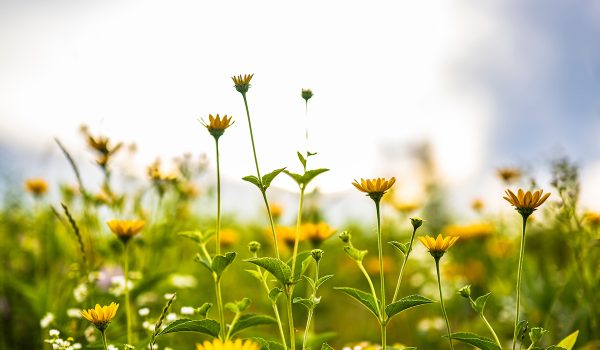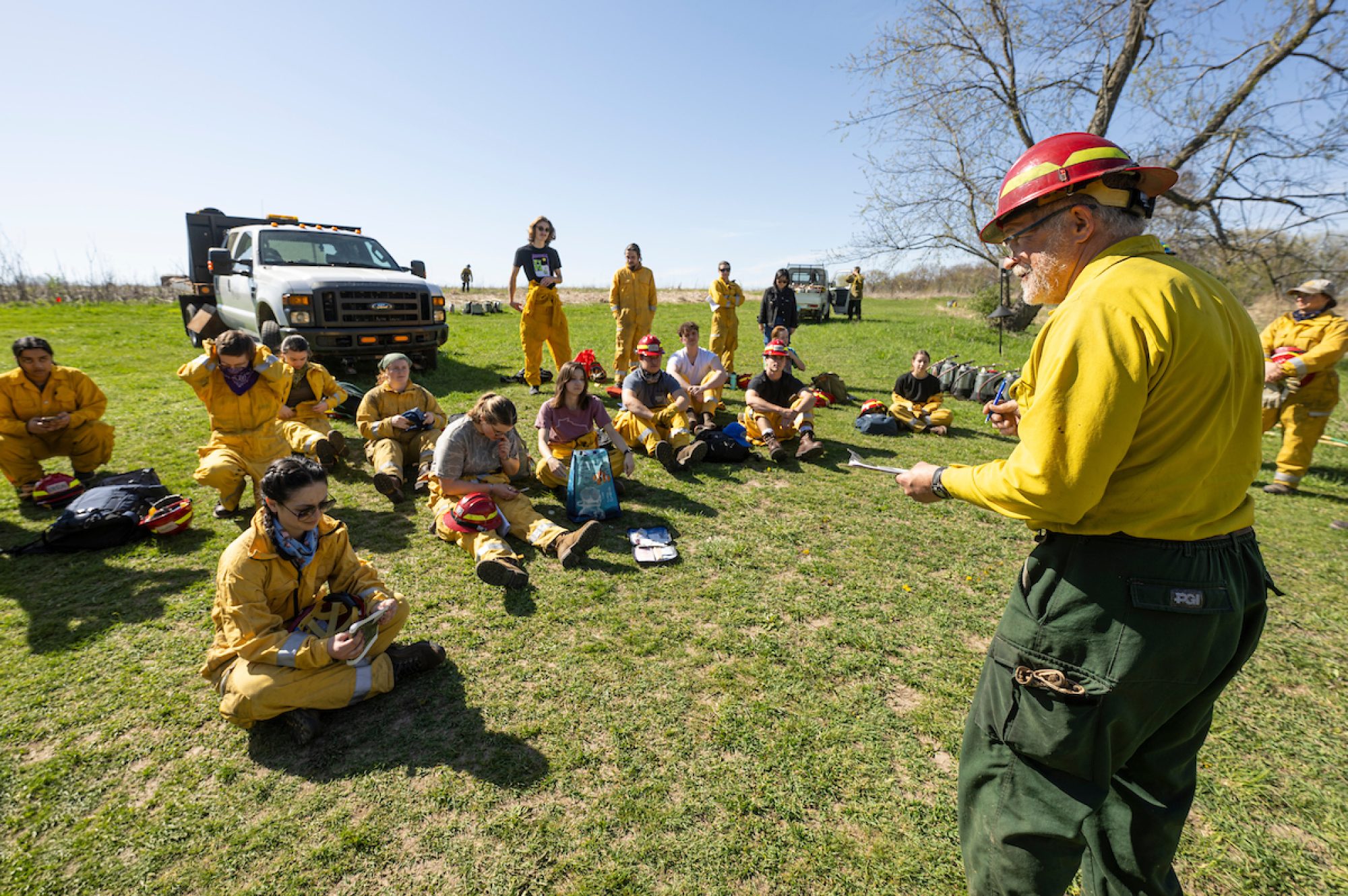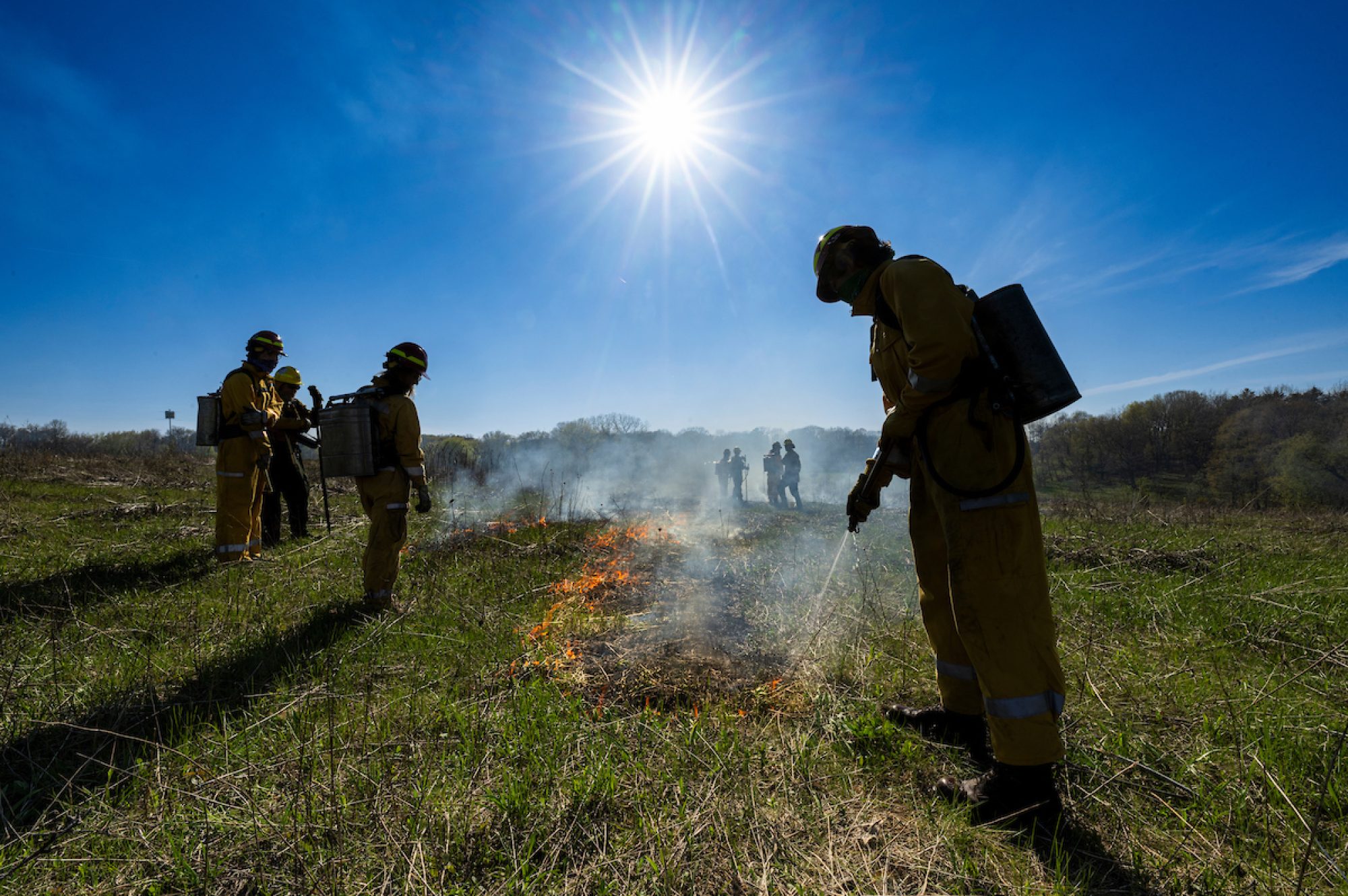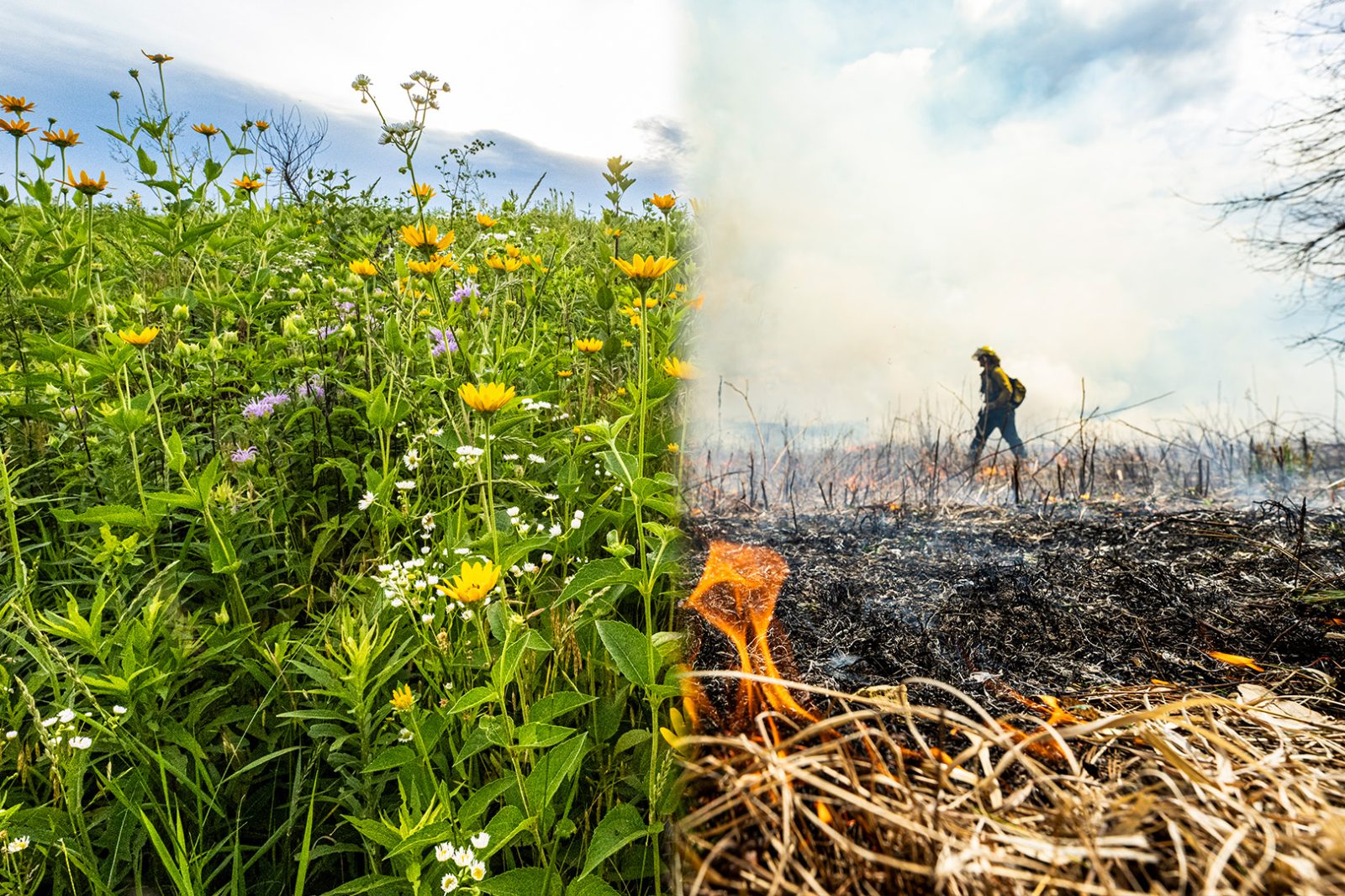
Burning and Learning
UW–Madison restores landscapes with fire, on campus and beyond.
Passing by a blooming prairie in the glow of dusk can be a magical, inspiring experience, whether witnessed from the car on a drive through rural Wisconsin or while immersed on a stroll through the UW–Madison Arboretum. While easy to take for granted, the prairies you see today are an increasingly precious and threatened resource. And that’s why UW–Madison is working to restore and preserve them — with fire.
Over time, human development has broken up Wisconsin’s prairies and oak savannas, the native landscapes defined by large, open grasslands and dotted by oak trees. They have been replaced by agricultural fields, neighborhoods, towns and highways. The Wisconsin Department of Natural Resources estimates that only one-tenth of one percent of original prairie still exists today. Now, even the fragments that remain are in danger of disappearing.
Unlike the wildfires that wreak havoc in today’s warming world, prescribed burns nurture the ecosystems that have evolved naturally with fire for millennia. Prior to urban and agricultural development, fires started by natural events like lightning strikes could burn through prairies and dispose of dead plants from the prior season, stimulating growth for new, more productive plants.
But now, fires can’t spread naturally across these fragmented ecosystems. And this gives invasive species a chance to establish, crowd out native species, and interfere with other ecosystem processes like groundwater recharge, carbon storage and nutrient cycling.
Prescribed burns, when conducted safely and effectively, replicate the once-natural event of prairie fires. It’s a practice that’s long been used and proven effective by some Native American tribes to manage their land and promote growth of desired plants.
And now with a team of staff, students, volunteers and farmers, UW–Madison is helping to spread the word — and the fire — both on campus and off.
A UW instructor helps farmers ignite sustainable practices
UW–Madison instructor Jeb Barzen, who teaches an increasingly popular class on the subject, has been organizing prescribed burns in his Spring Green, Wisconsin, community for many years.
He was initially inspired by the land ethic popularized by UW–Madison ecologist Aldo Leopold. To Barzen, it’s about seeing yourself as interconnected with not only the people around you, but also with the animals, plants, land and even nonliving resources. Now he wants to give people the tools to enact it.
“People have done a great job adopting that land ethic, believing in it across a political spectrum. What we haven’t done is … given those same people the tools to actually implement [it],” says Barzen, an honorary fellow with the Nelson Institute for Environmental Studies. “Prescribed fire is a way of providing the tools that are necessary to accomplish the goals that most people can agree upon.”
Barzen is not alone in this perspective. Over the years, more and more organizations, private landowners and farmers have asked him to help conduct burns on their property. It’s become such a popular practice that demand outweighs capacity. But Barzen helps as much as he can, along with volunteer groups around the state.
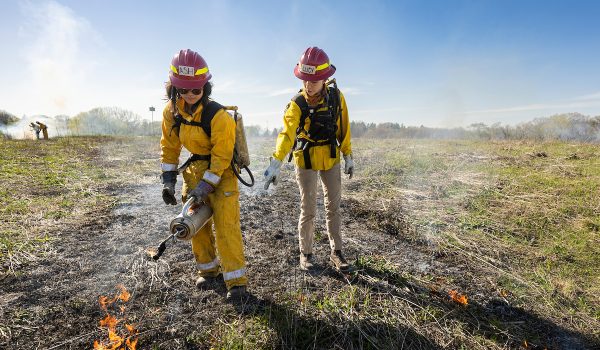
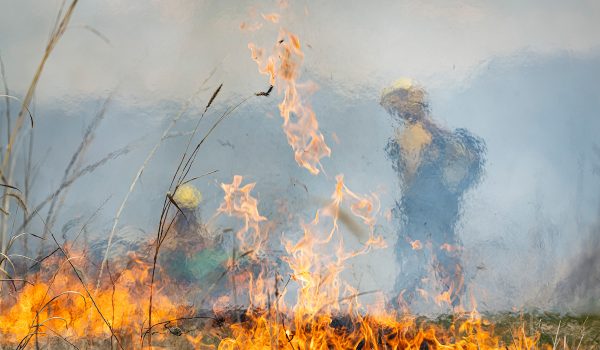
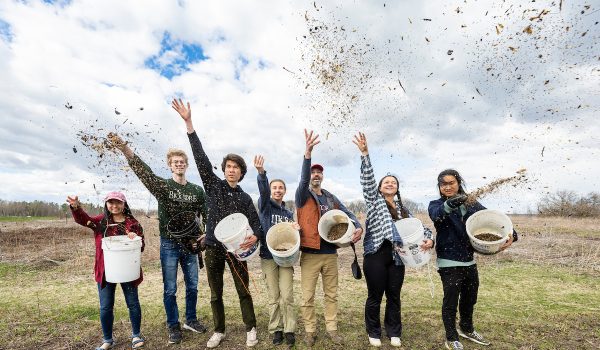
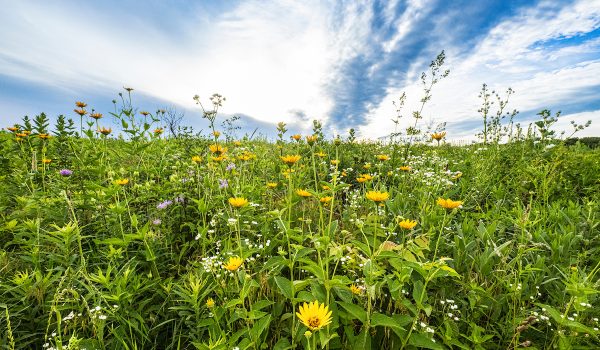
Gary Bula Farms in Adams County is one of Barzen’s many success stories. Potato growers Lynda and Gary Bula had expressed an interest in conservation and restoration but weren’t sure where to start. Then their daughter Tamra “Tammy” Bula-Garz participated in a burn school that Barzen taught through the Healthy Grown certification program, a partnership between UW–Madison and the Wisconsin Potato and Vegetable Growers Association. It provides farms access to resources for more sustainable and regenerative agricultural practices.
Soon after, Bula-Garz hosted a burn on the property that was conducted by Barzen, volunteers and students from UW–Madison and UW–Stevens Point. Her family has now been burning under Barzen’s guidance for 10 years. She says the partnership with UW–Madison has provided her and other farmers with access to the latest expertise and science. But it’s also helped university experts learn what Wisconsin farmers are interested in and what resources they need.
“Our farm wants to be part of something bigger. And the consumer these days wants to know that their food is coming from responsible producers,” Bula-Garz says.
There’s also the joy that comes from walking through land restored to its natural beauty. One of her favorite patches of land, a strip of oak savanna surrounded by bits of prairie between crop fields, used to be impassable because of invasive shrubs like buckthorn.
Now, thanks to the regular burns, Bula-Garz and her family can stroll through the trees and among native plants such as the stemless lady’s slipper. They can hike, hunt and fish in the nearby pond — experiencing the land as it was meant to be.
“Instead of taking away habitat, we’re regenerating it,” Bula-Garz says. “I think too many times in agriculture, we’ve always been accused of just taking it away, and now we want to do something better and give it back.”
Campus burns restore landscapes and train the next generation
Back in Madison, the university regularly conducts prescribed burns within the Arboretum and Lakeshore Nature Preserve to restore native prairie landscapes on campus.
The Arboretum’s use of prescribed fire goes all the way back to the 1940s, when Aldo Leopold started as research director and most of the property was abandoned agricultural fields. Fire was used as part of a series of restoration experiments to return the fields back to their natural state as a tall grass prairie.
These early research burns at the Arboretum — led by UW–Madison ecologists John Curtis and Max Partch — were instrumental in introducing fire as a tool in the burgeoning restoration movement across the United States.
Today at the Arboretum and other university properties, land care manager Michael Hansen leads the prescribed burns of prairies and oak savannas. The fire is rejuvenating native vegetation, reintroducing biodiversity, and increasing the production of seeds that can be harvested and planted in other restoration areas. In the spring, new growth starts popping up from the black, charred ground within a matter of weeks of a prescribed burn.
“It feels pretty good to see that regrowth, especially coming out of a long, cold, gray winter, and to help play a role in that,” Hansen says.

Aldo Leopold with a group participating in controlled prairie burn on the UW–Madison Arboretum in the mid-1940s. From left to right: Pepper Jackson, Aldo Leopold, Jim Hale, Mary Ellen Helgren. UW–Madison Archives
The Arboretum, along with Lakeshore Nature Preserve, partners with Barzen and his class on the campus burns. Students learn the ins and outs of the equipment used to safely do the work: heavy backpack water pumps, rubber flappers and drip torches. They even conduct supervised burns in the Arboretum’s historic Curtis Prairie, on the very same land Curtis and Partch began their restoration experiments.
“You can see some gray in my beard,” Hansen says. “So, it’s important to get young people involved in prescribed burns, and being part of the university provides us with a good avenue to do that.”
But Barzen and Hansen aren’t just training the next generation of burn crew members.
“We’re getting burns done. We’re moving conservation forward,” Barzen says.

